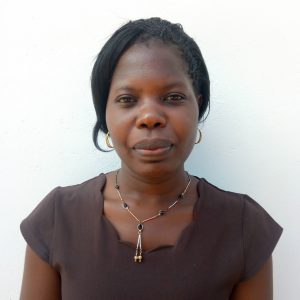June, 2021: Odongo Spring Project Complete!
Ikoli Community now has access to clean water! We transformed Odongo Spring into a flowing source of water, thanks to your donation. Our team protected the spring and trained the community on improved sanitation and hygiene practices, including COVID-19 prevention.

Field Officer Joyce Naliaka (wearing mask) and community members celebrate the completed spring at the handing-over celebration, including Miriam Okumu, second from right.
"Being a farmer, safe water will, of course, be a key point in my farming activities which require a lot of water. The water will also be helpful in my domestic duties, hence my general hygiene will improve by a bigger margin," said Miriam Okumu, a farmer in the community.

A gesture of thanks between Water User Committee Chair Wilimina Atitwa and Field Officer Joyce.
"The water point will be key in kick-starting my irrigation plans which have been derailed by lack of sufficient water. Secondly, my cows and goats will be able to access water easily - something which was difficult before the spring was completed. This will in turn increase their productivity."

"Thank you, Milliman Group! Spring #2 Complete!"
Children were just as excited as the adults about the new water point.
"Before the spring was built, I used to go a long distance to fetch water for the cattle. However, the spring being this close means water will be easily accessible, which in turn will save more time for studies," said young teenager Abel.

Abel fetches water.
"The water point, I believe, will enable my parents to pay my academic fees which would be achieved from their irrigation projects."

Preparing for Spring Protection
Community members worked together to source and carried all locally available construction materials to the spring. These included bricks, sand, stones, and fencing poles. Some people also chiseled away at large stones to break them down into the gravel. Because people have to carry most items by hand, the materials collection process can take anywhere from a few weeks to months.

Community members deliver construction materials to the spring site.
When everything was prepared, we sent a lorry to the community to deliver the rest of the construction materials, including the cement, plastic tarps, and hardware. Then, our artisan and field officers deployed to the spring to begin work. Individual households provided meals throughout each day to sustain the work team.
From Open Source to Protected Spring: A Step-by-Step Process
At last, it was time to dig in at the spring! Women and men lent their strength to the artisan each day to help with the manual labor. First, we cleared and excavated the spring area. We dug a drainage channel below the spring and several surface runoff diversion channels above and around the spring. These help to divert environmental contaminants carried by the rains away from the spring.

Taking measurements during excavation.
To ensure community members could still fetch water throughout the construction process, we also dug temporary diversion channels from the spring’s eye around the construction site. This allowed water to flow without severely disrupting community members’ water needs or the construction work.

Pouring the foundation
Excavation created space for setting the spring’s foundation made of thick plastic tarp, wire mesh, concrete, and waterproof cement. After setting the base, we started brickwork to build the headwall, wing walls, and stairs.

Bricklaying
Next, we began one of the most crucial spring protection steps to ensure a fully functional water point: setting the discharge pipe. The discharge pipe has to be low enough in the headwall so that the water level inside never rises above the spring’s eye, yet high enough to leave eighteen to twenty inches between the pipe and the spring floor. This allows room for the average jerrycan (a 20-liter container) to sit beneath the pipe without making contact.

Setting the pipe
If the discharge pipe were placed too high above the spring’s eye, too much backpressure could force the flow to emerge elsewhere. Too low, and community members would not be able to access the water easily. We embedded the pipe using clay (or mortar when the clay is in short supply) and placed it at a slight incline to ensure water flows in the right direction.

Stone pitching
In coordination with brickwork, we pitched medium to large stones on both sides of the spring’s drainage channel. We then cemented and plastered each stone group into place, forming the rub walls. These help to discourage people and animals from trying to stand on that area, which could cause soil erosion and thus a clogged drainage area.

Stairs construction
With brickwork and stone pitching completed, we turned to cementing and plastering both sides of the headwall and wing walls. These finishing layers reinforce the brickwork and prevent water in the reservoir from seeping through the walls. In turn, enough pressure builds in the reservoir box to push water out through the discharge pipe.

Plastering
As the headwall and wing walls were curing, we cemented and plastered the stairs and installed four tiles beneath the discharge pipe. The tiles protect the concrete from the falling water’s erosive force while beautifying the spring and facilitating easy cleaning of the spring floor.

Backfilling
We transitioned to the final stages of construction with the tiles in place - backfilling the reservoir box. First, we cleared the collection box of any debris that may have fallen in since its construction, such as dead leaves or other items. Then we redirected the temporary diversion channels back into the reservoir box, channeling water into this area for the first time. We closed off all of the other exits to start forcing the water through the discharge pipe only.

Backfilling
With much help from the community, we filled up the reservoir area with the clean and large stones they gathered, arranging them in layers like a well-fitting puzzle. We covered the stones with a thick plastic tarp to minimize potential contamination sources from aboveground, followed by a layer of soil. We piled enough soil on top to create a slight mound to compensate for the backfill’s future settlement.

Planting grass inside the fence
Community members transplanted grass onto the backfilled soil to help prevent erosion. Finally, the collection area was fenced to discourage any person or animal from walking on it since compaction can lead to disturbances in the backfill layers and potentially compromise water quality.
The entire construction process took about two weeks of work and patience to allow the cement and plaster to finish curing. As soon as it was ready, people got the okay from our field officers to fetch water.

Women celebrate the protected spring while fetching water.
We officially handed over the spring directly following training to mark the community's ownership of the water point. During the dedication ceremony, most if not all community members turned up. This was occasioned by singing and dancing as the community members were grateful for the project which to them would be helpful in dealing with their water shortage. Happiness, thanksgiving, and appreciation were the order of the day flowing in all directions.

Training on Health, Hygiene, COVID-19, and More
Due to the ongoing challenges and restrictions amidst the pandemic, we worked with local leaders and the national Ministry of Health to gain approval for a small group training about health, hygiene, and COVID-19 prevention.
Together with the community, we found their preferred date for training while considering other community calendar events, such as the agricultural season and social events. We requested a representative group of community members to attend training, who will relay the information learned to the rest of their family and friends.

Community members mask up at training.
When the day arrived facilitators Joyce, Adelaide, and Elvine deployed to the site to lead the event. Thirteen people attended the training including community-based leaders and self-help group members. On the day of the training, the weather looked gloomy since it was the rainy season. This made it more ideal for the training to be conducted close to the spring.

Physical distance check
Perhaps the most crucial topic of the day was our session on COVID-19 prevention and control. Due to the rampant spread of misinformation about COVID-19, we dedicated time to a question and answer session to help debunk rumors about the virus and provide extra information where needed.

Practicing using the elbow for safer coughs and sneezes
We covered several other topics, including community participation in the project; leadership and governance; personal and environmental hygiene; water handling and treatment; operation and maintenance of the spring; dental hygiene; the ten steps of handwashing, and how to make and use a tippy tap and leaky tin. We held an election for the newly formed water user committee leaders during the leadership and governance session.

Active question and answer session
We also brainstormed income-generating activities that can be used to start a community savings account for any future minor repairs to the spring and a cooperative lending group to enable members to develop small businesses.
The most memorable moment from training was during the session on water pollution and hygiene. Members were surprised to find out that water should not be kept in their water pots for more than three days due to the risk of bacteria or other contaminants affecting their water. Most of the community members said that they have been storing water in their pots for even a month considering the fact that they have small families.

Site management training at the spring
Another memorable moment was during the site management training session held at the spring. For the community members who were not present during the implementation process but attended training, they got excited at their first sight of the protected spring. They were amazed that the spring was now very safe and access was good from both sides of the spring.

Two-sided staircases help ease entry and exit at the spring.
"The training was very valuable to me because I had no knowledge of almost every topic that was being addressed, hence, the knowledge acquired would play a big role in my handling and managing of some situations in future," said Joyce Naomi, the community's organizer.
"The training was very valuable because generally, it has impacted my knowledge of the virus. Secondly, I have been made to understand that hygiene should always be key in my day-to-day operations. I could say that the training really impacted my hygiene, especially regarding my hands, which I had never taken a keen interest in cleaning. Therefore, the training really helped me," said Wilimina Atitwa, the elected Chair of the spring's water user committee.

Kids at the spring
"When the outbreak was announced in our country, as a community we had heard that the virus spread faster when in large crowds, so we took it upon ourselves to reduce communal meetings in order to curb its spread," Wilimina explained.
"As a community, we plan to really emphasize the importance of handwashing and social distancing which will play a bigger role in curbing the spread of the virus. My general feeling about the virus is for it to just disappear because it has really impacted our lives, but all in all, I have no worries because I'm very sure all my family members have taken the correct measures to curb it."

Women, including Water User Committee Chair Wilimina Atitwa (left), celebrate the spring.
When an issue arises concerning the water project, the water user committee is equipped with the necessary skills to rectify the problem and ensure the water point works appropriately. However, if the issue is beyond their capabilities, they can contact our field officers to assist them. Also, we will continue to offer them unmatchable support as a part of our ongoing monitoring and maintenance program.
Thank you for making all of this possible!


 Protected Spring
Protected Spring
 Rehabilitation Project
Rehabilitation Project















































